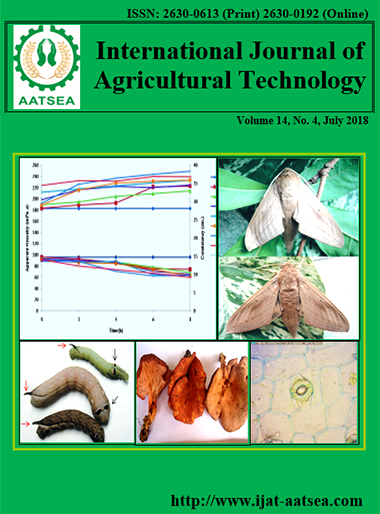Yoghurt Production from Germinated Native Black Rice (Maepayatong Dum Rice)
Main Article Content
Abstract
The incubation period of 12, 24, 36, 48, 60, and 72h for germination on the quantity of γ-amino butyric acid of native black rice (Maepayatong dum rice) were conducted. The result found that the 48h of germination time had significantly (p ≤ 0.05) the highest amount of γ-amino butyric acid (27.99 ± 1.44 mg/100 g). This treatment was therefore selected to further determine the product development of germinated native black rice yoghurt. Changes in physical and chemical properties during fermentation under controlled conditions (42°C) at 0h, 2h, 4h, 6h and 8h fermentation were evaluated. The result found that change in the amount of titratable acidity expressed as lactic acid and apparent viscosity of germinated black rice yoghurt were increased at the end of 8h fermentation. On the other hand, the consistency, pH, and total soluble solid were slightly decreased and the lowest at the end of 8h fermentation. From sensory evaluation, the germinated native black rice yoghurt fermentation by 20% w/w of Revon starter) had the highest overall acceptability (6.88: moderately like). It was then chosen to study on the effect of shelf life on yoghurt properties every week until 4 weeks of storage. The consistency, pH, and viable cell count were slightly decreased; while apparent viscosity, lightness, redness and lactic acid were increased when the shelf life was longer. Interestingly, the free radical scavenging capacity assayed by DPPH method showed that IC50 values had significantly (p≤0.05) higher than the control (86.92±1.21 and 96.61±1.25 mg/ml, respectively). Although, the amount of γ-aminobutyric acid (GABA) content exhibited significantly (p≤0.05) two fold lower than the control (0.99±0.03 and 1.80±0.07 mg/100g, respectively). It concluded that the research finding could increase the value addition of native black rice and should be guided to develop the other healthy food in the future.
Article Details

This work is licensed under a Creative Commons Attribution-NonCommercial-NoDerivatives 4.0 International License.
References
Anawachkul, M. and Jiamyangyuen, S. (2009). The study of GABA content and development of GABA-enriched yogurt from germinated red rice (Munpu rice). Kasetsart Journal 43: 224-231.
AOAC (1990). Official method of analysisvol 1, 15th Ed, Verginia, USA: Association of Official Analytical Chemist. Inc. pp. 69-75.
Banchuen, J., Thammarutwasik, P., Ooraikul, B., Wuttijumnong, P. and Sirivongpaisal, P. (2010). Increasing the bio-active compounds contents by optimizing the germination conditions of Southern Thai Brown Rice. Songklanakarin Journal of Science and Technology 32:219-230.
Karahara, H. (2004). Germinated brown rice. Department of Sciences of Functional Food, Shinshu University, Japan. pp. 1-32.
Karovicova, J. and Kohajdova, Z. (2003). Lactic acid fermented vegetable juice. Horticultural Science 30:152-158.
Komatsuzuki, N., Tsukahara, K., Toyoshima, H., Suzuki, T. Shimizu, N. and Kimura, T. (2005). Effect of soaking and gaseous treatment on GABA content in germinated brown rice. Journal of Food Engineering 78:556-560.
Lee, W. J. and Lucey, J. A. (2010). Formation and Physical Properties of Yogurt. Asian-Australasian Journal of Animal Science 23:1127-1136.
McKinley, M. C. (2005). The nutrition and health benefits of yoghurt. International Journal of Dairy Technology 58:1-12.
Mongkontanawat, N and Lertnimitmongkol, W. (2015). Product development of sweet fermented rice (Khao-Mak) from germinated native black glutinous rice. Journal of Agricultural Technology 11:501-505.
Okada, T., Sugishita, T., Murakami, T., Murai, H., Saikusa, T. and Horio, T. (2000). Effect of the defatted rice germ enrich with GABA for sleepless, depression, autonomic disorder by oral administration. Journal of the Japanese Society for Food Science and Technology 47:596-603.
Panyanak, P., Suwanketnikom, S., Tonhang, S. and Siripoonwiwat, W. (2010). Correlations between seed characteristics, seed germination and -aminobutyric acid (GABA) content of 14 rice cultivars. Thai Journal of Botany 2:97-113.
Pongpipatpong, M., Wongkachang, K., Mechan, N., Jaidee, S. and Kanjanapimon, S. (2013). Production of powdered beverages from germinated soybean and black sesame. The 14th TSAE National Conference and the 6th TSAE International Conference: 2013. Prachuap Khiri Khan Thailand. pp. 545-550.
Sangkitikomon, V., Tentumnou, T. and Rodchanasasod, A. (2008). Comparisions of total antioxidants of red rice, black rice and black sticky rice.Journal of nutrition 43:16-21.
Sharma, V. and Mishra, H. N. (2008). Fermantation of vegetable juice mixture by probiotic lactic acid bacteria Nutrafoods 12:17-22.
Tadashi, A., Yoshiatsu, K., Wen Bin, Y. and Toshihiko, K. (1998). High performance liquid chromatographic determination of β-alanine, β-aminoisobutyric acid and γ-aminobutyric acid in tissue extracts and urine of normal and caminooxy acetate-treated rats. Journal of Chromatography B 712:43-49.
Tananuwong, K. and Tewaruth, W. (2010). Extraction and application of antioxidants from black glutinous rice. LWT-Food Science and Technology 43:476-481.
Watts, B. M., Yumaki, C. L., Jeffery, L. E. and Elais, L. G. (1989). Basic sensory methods for food evalution. The International Development Research Centre, Canada: The Centre.
Zhu, K., Zhou, H. and Qian, H. (2006). Antioxidant and free radical scavenging activities of wheat germ protein hydrolysates (WGPH) prepared with catalase. Process Biochemistry 41:1296-1302.


